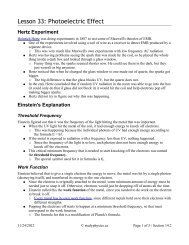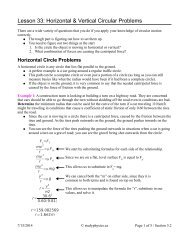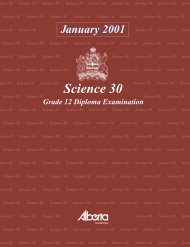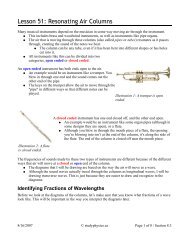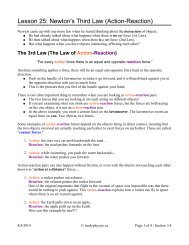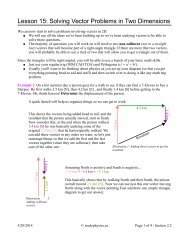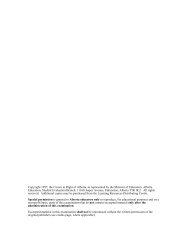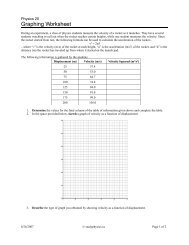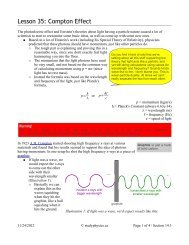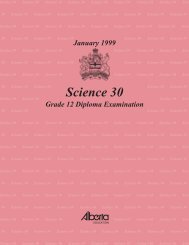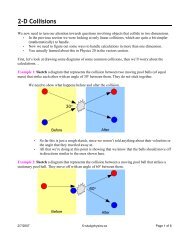Laboratory Report Format & Marking Rubric - Mr. Clintberg's ...
Laboratory Report Format & Marking Rubric - Mr. Clintberg's ...
Laboratory Report Format & Marking Rubric - Mr. Clintberg's ...
- No tags were found...
You also want an ePaper? Increase the reach of your titles
YUMPU automatically turns print PDFs into web optimized ePapers that Google loves.
Each Group Member's Full NameBlock NumberDateTitle of LabI. Objective:State what you are trying to do or discover. This is usually a simple, single sentence that does NOT talk about howyou are going to try to figure it out.II. Hypothesis:Three parts to this section. First, make an educated guess as to what you think the outcome will be (probably anaccepted value). Make sure you actually give an answer to what our objective is asking... don’t start discussingother stuff. Second, you must show the formula (explaining its variables with units) that is the basis of your lab. Donot include “math” formulas. Third, list the manipulated, responding, and controlled variables for your lab.III. Equipment:Make a list (in point form like a shopping list) of the equipment you will be using. You do not list things like yourpencil and calculator. We only need to know about the equipment that was necessary for you to perform theexperiment itself. Sometimes you might want to include a labeled diagram of the setup you used.IV. Procedure:Make a numbered outline of the steps you did to actually perform the lab itself. Be brief but complete. As a rule ofthumb, I should be able to show your lab to a grade seven student and they would be able to complete the lab basedon your instructions, even though they might not understand what the lab is about. Don't bother telling me to“gather materials” or to “clean up at the end.” Do not explain how to analyze the data here.V. Pre-Lab Questions:Sometimes I might assign questions you are supposed to answer before starting the lab. Answer those questionshere.VI. Observations:Most of the time you measured a bunch of numbers during the lab. These are your quantitative measurements, andthey must be organized in a table. If you noticed noteworthy things, like a smell or color, you may also describethese qualitative measurements here. Calculations or calculated numbers do NOT belong here!VII. Analysis:This is where you do your “number crunching.” Show any calculations that you need to do with your observationsto come to a “final answer.” If you need to make a graph based on your data and analyze something like its slope,all that work belongs here also. If you want, this work can be shown on a separate sheet of paper in pencil.VIII. Error:List things that might have caused mistakes to happen while performing your lab... be specific and complete. Keepin mind that listing things like “wrong formula” or “calculation errors” are not acceptable, since they are mistakesin your own work, not errors in performing the lab. You will also calculate percentage error or percent difference (ifapplicable) in this section to figure out how far off you are. If you want, the error calculations can be shown on aseparate sheet of paper in pencil.IX. Concluding Statement:Tie everything up here. Discuss your objective... did you answer it? Compare your hypothesis to your results... dothey agree? Comment on your observations and analysis. Would you do something different next time? Can yousuggest a different lab that is somehow related to this one? Use full sentences, and expect to write a pretty bigparagraph.X. Post-Lab Questions:If any other question were assigned to you to answer after the lab, answer them here.25
Appendix B: <strong>Marking</strong> <strong>Rubric</strong>The following marking rubric will be applied to each section of your lab report. A typical lab report without any pre or postlab questions will be out of 24 marks. Failure to follow the format guidelines given will result in the following penalties:Misnamed file (like “lab report.doc) = -1 markDisallowed file format (like docx file) = -1 markMissing information from top right of lab (e.g. name, block, date) = -1 markFailure to follow order of write up = -1 markCritical spelling or grammatical errors = -1 markEach day late = -5% of lab markObjectiveHypothesisEquipmentProcedurePre-Lab QuestionsObservationsAnalysisErrorConclusionPost-Lab QuestionsExcellent (3) Good (2) Poor (1) Unacceptable (0)Clear and concise statementof goal.Reasonable educated guess,formula shown, variablesidentified.Point form list of requiredequipment. Diagram ifnecessary/Step-by-step numbered listthe show how to do the lab.Collected quantitative datais well presented in a table.Qualitative data may begiven if necessary.Well laid out and calculatedanalysis based on data.Graphs (if needed) followall rules and haveappropriate calculationsshowing relationshipbetween calculated valueand physics concept.Several sources of error arelisted, and each is wellexplained. Showscalculation of error (ifappropriate).Wraps up the lab, just likethe conclusion of an essayfor English.Workable statement ofgoal, some fuzziness.Good guess and formula.Vital items listed, maybeone omission.Possible to do the lab,although someassumptions might haveto be made. Might not benumbered,Purpose of lab notclearly identified orunderstood.Guess or formula ismissing.So many omissionsthat performing the labwould be difficult.Difficult to followhow lab wasperformed. Steps gooff topic or areotherwise distracting.Varies depending on questions assigned, if any.All data is present, butshown in a format thatmay be confusing ormisleading.Calculations areessentially correct,although some parts maybe implied, includingvalues calculated fromthe graph.List of sources of error isincomplete. Calculationof error is wrong.Shows the person has notlost sight of the lab'sreason, but could focusmore on what's going on.Some data is missing.Data shown indisorganized or sloppymanner.Work is poorly shown,as if a rough draft.Serious calculationerrors affect results.Seriously lacking listof sources and/or nocalculation of error.Has serious troubleshowing link fromObjective through toConclusion.Varies depending on questions assigned, if any.“What was this lababout?”“I think Elvis isthe King!”“We used thatgreen gizmo withthe lights.”“Just do it ®”“Were wesupposed to writethat numberdown?”“The answer is5.4e6 m/s. Uh, ormaybe 2 m/s. CanI get back to onthis?”“My sock gotcaught on the dialthingy...is that aproblem?”“The End.”26
Appendix C: FAQQ: So it's ok if I call my file “momentum lab from steve joe and philip.doc.docx”?A: No. The file must be named using ONLY the last name of the person sending the file. Also, notice that the personsending it thought typing “doc” on the end would make it ok, but Word still saved it with “docx” on the very end. Checkfirst if you need help saving in the correct format.Q: I don't know how to set up a spreadsheet to graph.A: Watch the video Line Straightening and Graphing in a Spreadsheet on the multimedia page of www.studyphysics.ca.Q: If I copy and paste my graph into the lab document, do you still want the spreadsheet?A: Yes. If anything is squirrelly about your calculations, it might be necessary to look at the spreadsheet.Q: If I email the lab before midnight on the due date, when do I hand in the analysis stuff I wrote onpaper?A: Next school day.Q: I did my analysis / error calculations on paper, so I can skip that section in the lab write-up, correct?A: Nope. You still need to have those sections and tell me where to look for your written out work.Q: Where do I get that free program for making documents and stuff?A: LibreOffice.org27



